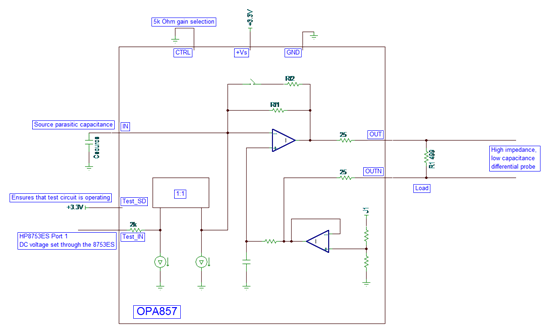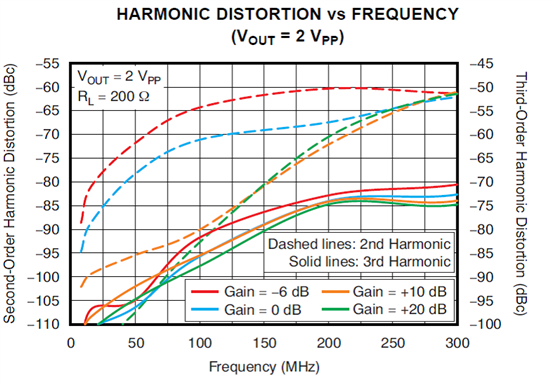How to evaluate a transimpedance amplifier (part 2)
In my previous blog on "How to evaluate a transimpedance amplifier, part 1", we looked at the OPA857 performance, but didn’t go in depth in explaining how those measurements were taken. Now that we’ve have established a reference, let’s work through the implementation.
To summarize, the main challenges to taking measurements with the OPA857 include:
- Transimpedance configuration
- Low input capacitance
- High output impedance
With a 20kW gain and a 1VPP output voltage swing the input current needs to be 50mAPP. Since the output voltage swing of the OPA857 is class A and the current flowing through a transimpedance is unipolar, the output common-mode voltage will need to be set appropriately.
The current source needs to be low capacitance, less than 1.5pF, to maintain the bandwidth. The output needs to be high output impedance to control the loading on the OPA857’s output. Since most of the test equipments we have are 50W input and output impedance, how do we resolve that problem while not impacting bandwidth, slew rate or distortion performance of the DUT (Device Under Test)?
This leads to individual solution for each measurement type.
The first measurement we will look at is the frequency response, or S21 parameter. For that we’ll use an HP 8753ES Network analyzer, a 30kHz to 6GHz S Parameter Network Analyzer. Both input and output are 50W impedance and AC-coupled. There are two ports in the back of the analyzer that allow controlling the DC voltage on either the input or output.
The two proposed signal chains to measure the OPA857 frequency response include:
- Using a high speed differential probe, see figure 1.
- Using a high speed buffer to isolate the network analyzer’s load, see figure 2.
Note that the Test_SD pin is set to a logic high (+3.3V) for the internal current source to operate properly. This implies that the DC voltage present on the Test_IN input will set the output voltage appearing on OUT and requires you implement the following procedure to ensure that the OPA857 operates optimally for an AC response.
- Minimize the AC signal.
- Set DC voltage at input such that the output voltage can swing around it preset common-mode voltage. For example, if the signal swing is 500mVPP, then the OUT DC voltage needs to be set to ≤1.4V. If this is not the case, the output swing will clip as the current in the class-A output stage runs out.
- After completion of #1, do not leave anything connected on the output. A probe lead or a voltage will add several pF to the load, altering the frequency response.
- Set the AC amplitude to the desired peak-peak output signal swing.

Figure 1: Circuit #1 using a fully differential probe to interface to the HP8753ES.

Figure 2: Circuit #2 using a BUF602 to interface to the HP8753ES.
The same approach is used to evaluate pulse response or any time domain measurement. Note however that since no resistor tolerance inside theOPA857 is better than ±15%, the setup will have to be calibrated device by device.
The approach described above will not work for measuring harmonic distortion, so how does this new problem get resolved?
The traditional approach for measuring harmonic distortion requires:
- A low distortion source
- A high dynamic range spectrum analyzer
The low distortion source is further improved by using a high order filter. The dynamic range of the spectrum analyzer can be improved by filtering the fundamental and measuring only the harmonics. The setup is shown in figure 3. The notch filter that can is placed after the DUT is omitted in this diagram.
Figure 3: Traditional harmonic distortion bench measurement setup.
In the case of the OPA857, we have two problems. The first one is that the source is a voltage source and that the input signal requires a current source. The internal current source cannot be used here as it does not have sufficient linearity. So we will have to develop a low distortion current source to enable the measurement. The second problem is the interface to the spectrum analyzer. The output of the OPA857 is pseudo-differential and requires driving a light load, whereas the spectrum analyzer requires a single-ended input and expects 50W.
A current source has high output impedance. In our case, the current source will need to have low input capacitance as well, so it cannot be generated using transistor-based circuit as a large transistor will also have a high intrinsic capacitance, not considering the package and board layout parasitic. This limits the approach to using a voltage source and converting it to a current using a resistor. In order to ensure that the noise gain of the OPA857 is close to 1V/V, the same as the transimpedance configuration, the source capacitance is minimal and the resistance is large enough to approximate this.
The source capacitance is minimized by careful insertion of a series resistor on the inverting pin. Please refer to the OPA857 EVM for the layout.
In our case, the gain resistor is five times the value of the transimpedance gain, so for 20kΩ, the current source impedance is 100kΩ. It is a compromise as the noise gain is. This represents a degradation of ~1.6dB due to the loss in loop-gain in the measurement which would not be present in a transimpedance configuration.
The OPA857 is operating in an attenuator configuration, so a 0.5VPP on its output now requires 2.5VPP from the generator further increasing the non-linearity from the source.
Looking at the output of the OPA857, we need to measure the nominal 500Ω load and also measure the non-linearity of the amplifier as the load is decreased to 5kΩ. So, again the interface between the OPA857 and the spectrum analyzer is not purely resistive as there is too much attenuation of the signal and parasitic capacitance on the output after the resistance would limit the effective bandwidth. If an active element is inserted in the signal chain, its distortion must be 15dB better than the expected measurement to degrade the measurement by 0.1dB. This tends to be a relatively easy requirement at low frequency, but is quickly unmanageable as the frequency increases. The solution here is to use a DVGA developed for the telecommunication market as it provides sufficient gain to compensate for attenuation in the signal path, since those DVGAs have a 200Ω input impedance, as well as convert the pseudo differential signal to fully differential and have sufficient linearity up to the frequency of interest. A transformer on the output of the DVGA converts the amplified fully differential signal and converts it to the single-ended input the spectrum analyzer expects. We will have some attenuation losses here as well to match the 50Ω input impedance of the test equipment. Finally the signal chain on the output of the OPA857 will look like the diagram shown in figure 4.

Figure 4: OPA857 with PGA870 used to adapt the OPA857 load into the Spectrum Analyzer.
The PGA870 provides additional gain with high linearity minimizing the measured linearity degradation. Looking into the PGA870 datasheet, we see that operating at high gain (> +10dB), both the 2nd and the 3rd harmonic distortion is greater than 90dBc for a 2VPP output swing. This ensures that theOPA857 measurement is degraded by less than 0.1dB.

Figure 5: PGA870 Harmonic distortion for 200Ω load.
In this blog, I have shown the techniques used to measure most of the typical characteristic curves shown in the OPA857 datasheet. For application information or how to implement the OPA857, refer to the datasheet and EVM user guide.
How to evaluate a transimpedance amplifier (part 2)的更多相关文章
- How to evaluate a transimpedance amplifier (part 1)
In this blog, I want take a different approach and describe the technical challenge encountered whil ...
- [转]What you need to know about transimpedance amplifiers – part 1
Transimpedance amplifiers (TIAs) act as front-end amplifiers for optical sensors such as photodiodes ...
- Could not evaluate expression
VS15 调试变量不能显示值,提示:Could not evaluate expression 解决办法: 选择"在调试时显示运行以单击编辑器中的按钮"重启VS即可. 可参考:Vi ...
- [LeetCode] Evaluate Reverse Polish Notation 计算逆波兰表达式
Evaluate the value of an arithmetic expression in Reverse Polish Notation. Valid operators are +, -, ...
- Evaluate Math Expression
Evaluate Math Expression eryar@163.com 摘要Abstract:本文简要介绍了数学表达式解析求值的几款开源软件,并结合程序代码说明了OpenCascade中表达式包 ...
- RobotFrameWork(四)变量运算与Evaluate
一.特殊变量运算: 执行结果: 二.Evaluate使用 函数释义:Evaluate是执行Python表达式,并返回执行结果 示例1: 执行结果: 示例2: 执行结果:
- 【leetcode】Evaluate Reverse Polish Notation
Evaluate Reverse Polish Notation 题目描述: Evaluate the value of an arithmetic expression in Reverse Pol ...
- 使用centos引导内核错误:kernel: pnp 00:0b: can't evaluate _CRS: 8
CentOS系统在开机过程中,一直遇到黑屏提示:“kernel: pnp 00:0b: can't evaluate _CRS: 8”,不理会它仍能启动系统并正常工作,未知何故. 经查,这是内核引导的 ...
- The Non-Inverting Amplifier Output Resistance by Adrian S. Nastase [ Copied ]
Source Address: http://masteringelectronicsdesign.com/the-non-inverting-amplifier-output-resistance/ ...
随机推荐
- 项目发布时候出错--项目文件包含 ToolsVersion="12.0"
项目文件包含 ToolsVersion="12.0".此工具集可能未知或缺失(您可以通过安装相应版本的 MSBuild 来解决该问题),或者该生成因策略原因已被强制更改为特殊 To ...
- sql基础查询
2.1 指定使用中的资料库 一个资料库伺服器可以建立许多需要的资料库,所以在你执行任何资料库的操作前,通常要先指定使用的资料库.下列是指定资料库的指令: 如果你使用「MySQL Workbench」这 ...
- ubuntu使用记录
常用指令 ls 显示文件或目录 -l 列出文件详细信息l(list) -a 列出当前目录下所有文件及目录,包括隐藏的a(all) mkdir ...
- React笔记_(7)_react路由
路由 路由(routing)是指分组从源到目的地时,决定端到端路径的网络范围的进程. 路由器当然是作为一个转发设备出现的,主要是转发数据包来实现网络互联. 那么react的路由到底指的是什么呢? 举个 ...
- linux,Mac下lu 一把
习惯Terminal没有不知道ls命令的(等同于DOS的dir),经常只是需要查看目录的内容大小,但ls -h显示的只是目录的本身大小,而且很多项内容 ls 在这方面的两个诟病出现了: 小诟1. 显示 ...
- Caused by: org.hibernate.HibernateException: Connection cannot be null when 'hibernate.dialect' not set
docs.jboss.org文档示例代码:(http://docs.jboss.org/hibernate/annotations/3.5/reference/en/html_single/) sta ...
- Linux下资源利用率监测利器—nmon使用
最近接了一个任务,就是测试公司服务器的资源利用率,这样对每种业务平时所占资源有了大体的了解,进而为下一步的虚拟化做准备.找了很多开源的工具,但都不理想,有的安装很复杂,需要联网(而我们的服务器很多都不 ...
- C#:简单线程样例
1.定义线程类及内部事件 using System; using System.Collections.Generic; using System.Text; using System.Threadi ...
- jqeury.base
min.js //前台调用 var $ = function (args) { return new Base(args); } //基础库 function Base(args) { //创建一个数 ...
- linux命令介绍:df使用介绍
linux中df命令参数功能:检查文件系统的磁盘空间占用情况.可以利用该命令来获取硬盘被占用了多少空间,目前还剩下多少空间等信息. 语法:df [选项] 说明:linux中df命令可显示所有文件系统对 ...
